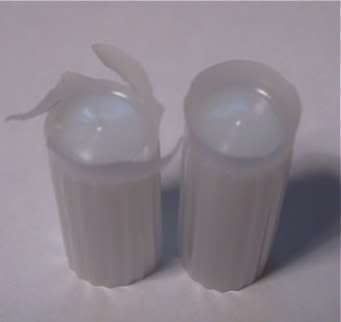I put up a post last weekend asking for assistance with inconsistent patterns out of my Pedersoli 10ga. SXS. I got several suggestions to try a wad configuration consisting only of thin over shot (OS) cards. This was primarily from results pictured and or mentioned in this posts Post#392376 and Post#395888 . I wanted to put up the results I got.
I finally got a chance to work on patterning again yesterday with this gun, trying out this new (for me) loading technique. Previously I had been working with a 3 dram powder load and 1.5 to 1.75 ounces of shot, hard over powder card, Styrofoam wad and two thin over shot cards. At times, this configuration would yield some good to excellent patterns. There were times however that the exact same load would be blown to pieces ”“ not good.
I have done a fair amount of patterning this spring, testing out various loads. I have done this in years past but, as I continue to learn more about these shotguns, I always want to try something new. To pattern my standard “target” for is a 21” X 17” sheet of paper with a 7 ½” X 6” orange square in the middle. The number of pellets in the orange is what I count and it is that number use for comparison. I have used this as a standard set up for several years now. Keeping this consistent allows me to compare notes from year to year.
First shot I tried was 85 grains of FFg, 4 OS cards perforated as mentioned in the post listed above, a 120 grain volume of #6 shot (or about 1.75 oz.), and two thin OS cards. This and all of the shots described here were through an extra full choke tube. The results of this load were disappointing ”“ only 8 pellets in the orange standard.
At this point I go back to the “equal volume” shot to powder load. The barrel was swabbed of fouling and reloaded with 100 grains FFg, and 100 grain volume of #6 (which works out to 1.4 ounces). Four perforated OS cards were loaded atop the powder, and two OS cards without perforation were placed on top of the shot. Results of this load were dramatically better.
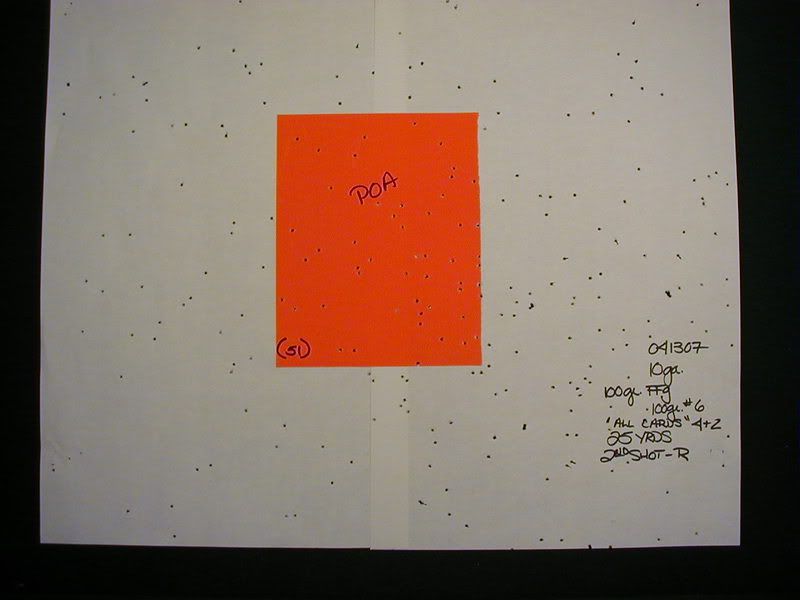
Fifty-one #6 pellets struck the orange standard on this shot. Of the 315 pellets in the load, 16% are striking the target area at 25 yrds., pretty good. I fired several more with both right and left barrels at 25 yrds, all with similar results. Satisfied that I now have a load that is consistently shooting turkey-killing shots @ 25 yrds, I put the pattern board out to 40 yrds.
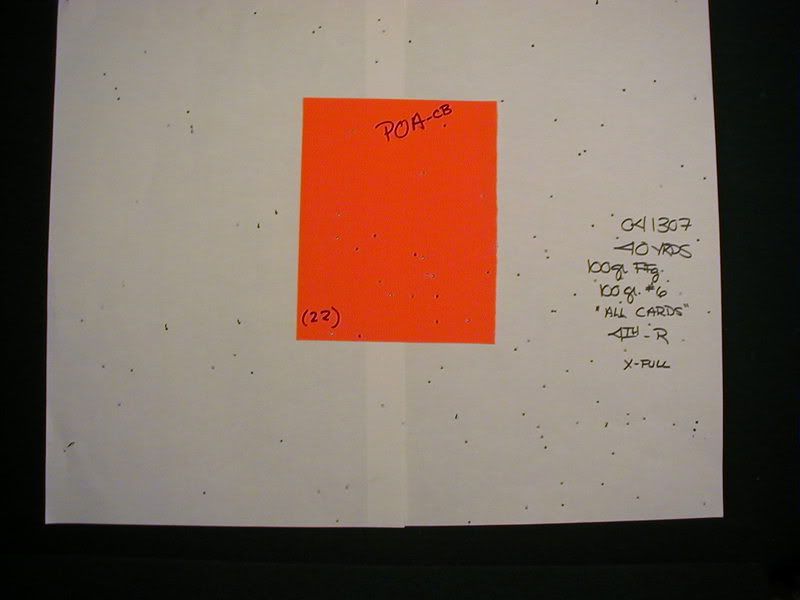
Using the same load I placed 22 pellets or 7% of the total shot into the orange standard. Though the pattern is really beginning to spread out at this point, I feel the pattern is sufficient to take a turkey at this range.
With this gun, I have noticed that there are some differences with the sight picture depending on which barrel you were using. On this forum, others have made the same observation with their Pedersoli SXS’s. The right barrel patterns on target best when using the center bead as POA placed right on the target. The left barrel will shoot a good foot left if you use this center bead as your POA like the pattern shot below.
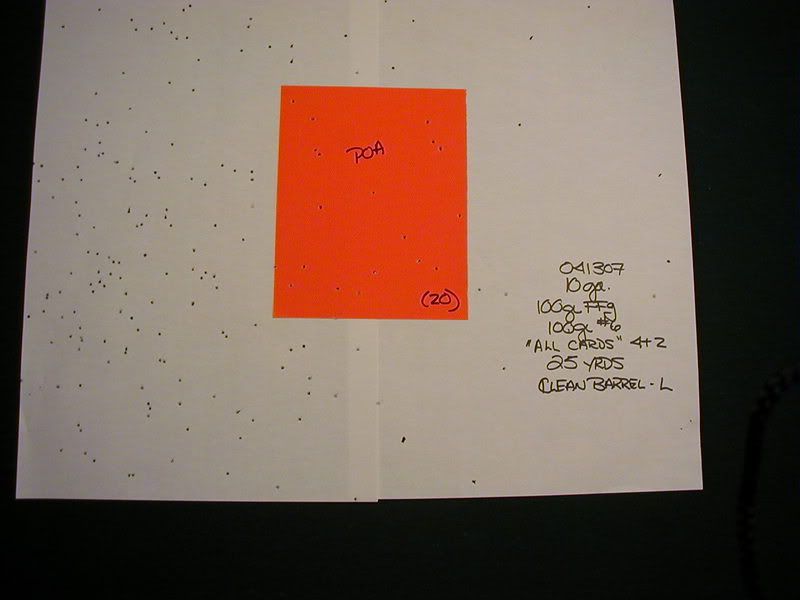
I had noted this difference in the sight pictureo of the two different barrels a few years ago. To compensate I installed secondary beads on both barrels to assist with sighting. I now use the bead of the left barrel as the sight for that barrel while the center bead is the sight for the right.
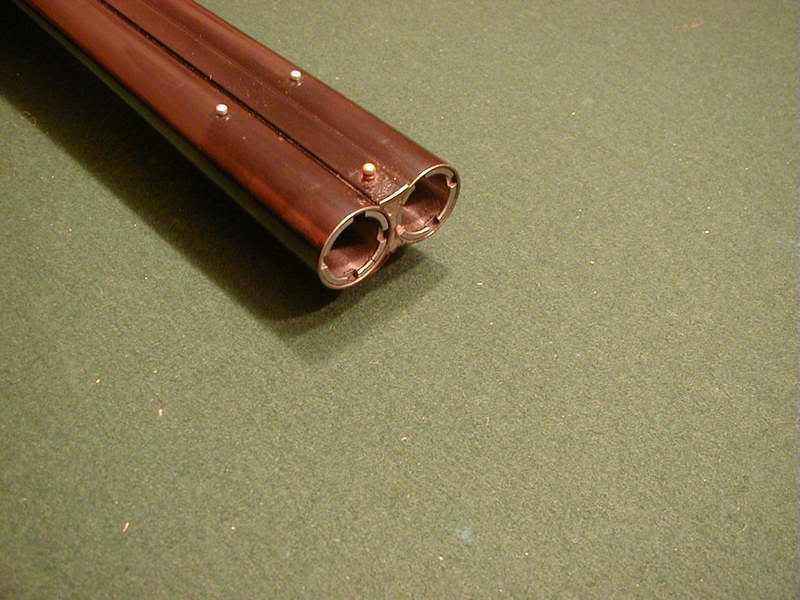
The “OS card only” load column using an equal volume of shot and powder has increased my maximum effective range of this gun 10 yrds, over my previous loads and has all but eliminated the problem I was having with inconsistency between shots. When turkey season starts here, I will essentially be going into the field with a new gun. Thanks Iron Jim and Paul V. for the suggestion.
I finally got a chance to work on patterning again yesterday with this gun, trying out this new (for me) loading technique. Previously I had been working with a 3 dram powder load and 1.5 to 1.75 ounces of shot, hard over powder card, Styrofoam wad and two thin over shot cards. At times, this configuration would yield some good to excellent patterns. There were times however that the exact same load would be blown to pieces ”“ not good.
I have done a fair amount of patterning this spring, testing out various loads. I have done this in years past but, as I continue to learn more about these shotguns, I always want to try something new. To pattern my standard “target” for is a 21” X 17” sheet of paper with a 7 ½” X 6” orange square in the middle. The number of pellets in the orange is what I count and it is that number use for comparison. I have used this as a standard set up for several years now. Keeping this consistent allows me to compare notes from year to year.
First shot I tried was 85 grains of FFg, 4 OS cards perforated as mentioned in the post listed above, a 120 grain volume of #6 shot (or about 1.75 oz.), and two thin OS cards. This and all of the shots described here were through an extra full choke tube. The results of this load were disappointing ”“ only 8 pellets in the orange standard.
At this point I go back to the “equal volume” shot to powder load. The barrel was swabbed of fouling and reloaded with 100 grains FFg, and 100 grain volume of #6 (which works out to 1.4 ounces). Four perforated OS cards were loaded atop the powder, and two OS cards without perforation were placed on top of the shot. Results of this load were dramatically better.

Fifty-one #6 pellets struck the orange standard on this shot. Of the 315 pellets in the load, 16% are striking the target area at 25 yrds., pretty good. I fired several more with both right and left barrels at 25 yrds, all with similar results. Satisfied that I now have a load that is consistently shooting turkey-killing shots @ 25 yrds, I put the pattern board out to 40 yrds.

Using the same load I placed 22 pellets or 7% of the total shot into the orange standard. Though the pattern is really beginning to spread out at this point, I feel the pattern is sufficient to take a turkey at this range.
With this gun, I have noticed that there are some differences with the sight picture depending on which barrel you were using. On this forum, others have made the same observation with their Pedersoli SXS’s. The right barrel patterns on target best when using the center bead as POA placed right on the target. The left barrel will shoot a good foot left if you use this center bead as your POA like the pattern shot below.

I had noted this difference in the sight pictureo of the two different barrels a few years ago. To compensate I installed secondary beads on both barrels to assist with sighting. I now use the bead of the left barrel as the sight for that barrel while the center bead is the sight for the right.

The “OS card only” load column using an equal volume of shot and powder has increased my maximum effective range of this gun 10 yrds, over my previous loads and has all but eliminated the problem I was having with inconsistency between shots. When turkey season starts here, I will essentially be going into the field with a new gun. Thanks Iron Jim and Paul V. for the suggestion.





